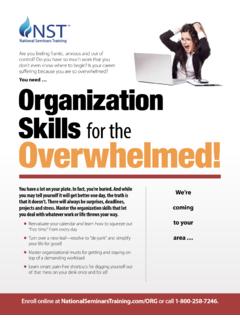Transcription of Dimensional Descriptors - images.ruceci.com
1 Dimensional DescriptorsWhen the broken and dotted lines intersect, they form four dimensions: the S, the E, the L and the F. Since the lines measure your Affiliativeand Directivetendencies, thecombination of the scores can indicate a group of are a todirectLowneed 7/24/06 11:07 AM Page 1 FactualStyle DefinitionCharacteristics: Stable, predictable, analytical, competentPersonal philosophy: It is importantEvaluates others by: Attention to detail, accuracy, personal standardsLeads others by: Creating systems, methods and processes to achieve goalsFears: Making a mistake, being wrong, losing influence and credibilityReacts to stress by: Withdrawing, overanalyzing, becoming aggressiveMotivated by: Accomplishment, tangible reward and recognition, logicShape interpretation Your Affiliative score is moderate to low (low need for contact with others) and you are low on the Directive scale (low need to control or direct those around you and your environment).
2 You demonstrate some characteristics of the Efficient. While your behavior is predominantly Factual, your A-slope (Affiliative) pattern makes you flexible across situations and able to adapt your social style to a particular situation. If your shape is the small A-slope, your response to situations is the most flexible. You primarily use Factual, then Efficient characteristics but will also demonstrate some characteristics of the strategies: By nature your communication style often uses technical terms and can be nonlinear. This frustrates the Efficient, Social, and Loyal styles. To communicate more effectively with the Efficient, eliminate technical terms and use concise, directive language that emphasizes the bottom line. Meet the needs of the Social and Loyal by using language that includes them and meets their interpersonal needs, (I see your point. I understand what you re saying.)
3 Increase your own communication effectiveness by learning how to communicate with feeling, diplomacy effectiveness strategies: You are highly precise and methodical and expect the same of others. When working with the Social and Loyal, avoid totally rejecting their creative ideas and flex your style to work collaboratively and accomplish goals. In the drive to reach a goal, the Efficient can sometimes cut corners or be too economical. When working with this individual help him or her see the value in using a standard process or procedure to get things done quickly and efficiently. Your A-slope pattern makes you very direct and factual. This can be a tremendous asset when working on complex and detailed projects. However, in a team environment, you are sometimes shy and reluctant to contribute. To work more effectively in this setting, freely share your knowledge and ideas with others cooperate to reach Limitations Exacting Thorough Factual Reserved Meticulous Practical High standards Calm Risk-avoider Slow to getthings done Perfectionist Withdrawn Dull Sullen Shy PassiveFun F Facts:Big Screen F s: Sir Anthony Hopkins Michael Caine Sigourney Weaver Kirk Douglas Cuba Gooding Jr.
4 Mark WahlbergOn-the-Tube F s: Jason Alexander Jill Hennessy Kiefer Sutherland William Sadler Megan Mullally Tyne DalyTotally Hot F s: Carrie-Ann Moss Jerry O Connell Maria Bello Julia RobertsOuter Space F s: George Lucas William ShatnerWorld Leading F s: Condoleeza Rice Donald Rumsfeld Queen Rania of Jordan In the animal world, the F would mostlikely be a wolf (highly intelligent,organized, and frequently workingalone). In the world of professional sports, the Fwould prefer to play chess or be alongdistance runner. In the Seinfeld sitcom, the ost like the Fcharacter m is 7/24/06 11:07 AM Page 2 Successful Working StrategiesIf you are in a working relationship with someone of this style,here are a few things that may be helpful to Working With Employees or PeersDOS Allow them the flexibility to be creative. They seek recognition and exciting challenges, so reward their efforts with your enthusiasm.
5 Channel their energy in appropriate directions (not always easy). Make sure they get lots of credit (they ll probably take it anyway). Respect need for socializing. Remember: We are important (philosophy).E They need control take advantage of their efficient, practical, ambitious nature and give them the reins when possible. Take advantage of their need to clear up messes when business isbad or the situation ambiguous, they ll be the best people to providestructure and get others back on line. Show respect for their traditional values and ways of thinking. Work with them to be more accepting of other methods of accomplishment. Remember: I am important (philosophy).L Remember their need to keep everyone happy and their skill at keeping the peace when business is good, these people will be the most effective leaders. Treat them fairly, supportively and openly. Allow them opportunities to interact with others.
6 Appeal to their principles and values. Remember: They are important (philosophy).F Listen; these people may not be the boldest or first to present ideas be assured, however, that they have a lot of great ideas. Work with them to set deadlines (you may often have to help them see the virtues of good enough ). Give them space to operate. Pay attention and appreciate their need for substance and credibility. Recognize they are practical and your supervisor/manager operates from one of thesedimensions, it may be helpful to remember these Working With Supervisors/ManagersDOS Be sociable. Be flexible, open and spontaneous. Show enthusiasm and excitement. Let them get lots of credit. Provide support by providing balance between them and other employees, subtly interject reality when necessary and keep things tidy and Recognize they are motivated by challenge. Play by their rules. Be on time, to the point, oriented toward results.
7 Show that you are keenly aware of their authority. Provide support by serving as a buffer between them and other employees, expose them to alternative ways of doing things, but document everything with emphasis on Openly express your thoughts, concerns, ideas. Be a team player, compromise, strive for consensus, build relationships. Take interest in your supervisor/manager as a person. Make it easy for them when they have to be directive. Provide support; set your own performance goals and get them Acknowledge their expertise. Give facts and data, and be consistent. Think things through and document ideas with facts from credible sources. Offer detailed, well-thought-out plans of action. Provide support by subtly providing energy and enthusiasm throughthe ranks, bringing in fresh, new approaches (but be sure to document and detail every aspect of your proposal). 7/24/06 11:07 AM Page 3 Successful Working StrategiesFor Working With Employees or PeersDON TS Stifle their energy by demanding their conformity.
8 Forget to show them your appreciation for their new and thoughtful ideas. Remember their motivations, don t be too put off by their unconventionality. They are motivated by opportunities and Get into their territory (they ll let you know). Go around them on issues when they should be involved. Be ambiguous or use excuses. Exhibit unassertive Take advantage of their eagerness to please. Be harsh or insensitive. Forget to acknowledge them when you pass them in the hall. Criticize or cause Pressure them, in the interest of expediency, to abandon their careful, exacting nature (it is these traits that keep the rest of us honest). Expect them to quickly get on board and initiate new projects without thinking them through first. Expect them to empathize (be emotional) in a crisis; instead, they ll use logic and Working With Supervisors/ManagersDON TS Openly argue. Expect them to have everything organized and carefully laid out.
9 Present one conclusion; instead, explore possible compromises/options. Use a win/loss Exhibit any behaviors that may be misinterpreted as laziness(they ll look for it). Expect more than a business relationship. Waste time chatting. Expect any Take advantage of their nature by slacking off. Forget the importance of maintaining social rapport and informal chats. Forget to listen and have Be false and ingratiating do your homework and stick to the facts. Be in a hurry to prove yourself or push through your new ideas. Appear arrogant or cocky. Expect a high risk or surprise in 7/24/06 11:07 AM Page 4 SELFS ocial Styles DimensionsSummarySocial MotivatorsDislikesDecision StylesWhen Things Don t Go WellThey WillAdaptive StrategiesWould Most Like You To(be)Their Worst Fears AreRecognitionsRoutineIndecisionSpontane ous(quick)Be accusing,blame it onothersTone it downsome, listenRecognize theirideas andachievementsLosing socialImageSuccessLaziness,irreverenceDe cisive (quick)Fight forcontrol, becomedefensiveListen, acceptothers differencesFollow andsupport theirgoalsLosing controlAcceptanceDissension,egotismInclu sive (slow)Submit, fall inlineSelf-indulgeSensitive of theirfeelingsLosingAcceptanceSubstancePu shers,phoniesMethodical(slow)Withdraw,se parateAssert, bespontaneousAccepting oftheir thoughtsBeing wrongand lookingfoolishSEL 7/24/06 11:07 AM Page 5














